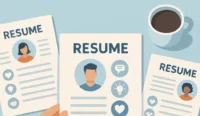This AI engineer cracked 10+ companies in 2025 by transforming her career from a $24,000 salary at Accenture to landing offers from top-tier companies including Oracle, Microsoft, Google, PwC, Deloitte, EY, IBM, and even government agencies. Khushi’s remarkable journey demonstrates how strategic skill development, resume optimization, and understanding market demands can lead to unprecedented career success in the AI field.
Starting from a small town in the Midwest, Khushi’s path to success wasn’t straightforward. After completing her Bachelor’s in Computer Science, she initially struggled with entry-level positions before joining Accenture as an application developer. However, her determination to master AI technologies and her strategic approach to career advancement led her to crack more than 10 companies in a single year, ultimately landing her dream role as a Senior AI Engineer at Oracle.
Her story is particularly inspiring because she achieved this success without traditional Data Structures and Algorithms (DSA) preparation, focusing instead on practical AI skills and real-world project experience. She understood that the AI revolution has created new opportunities that value practical skills over theoretical knowledge.
The Journey from Small Town to Big Dreams
Khushi started from humble beginnings in a small Midwestern town. Her journey began with excellent performance in computer science during high school, maintaining a 3.8+ GPA and developing a passion for technology. Initially planning to pursue a general IT degree, she managed to get into Computer Science, which became the foundation of her future success.
Her college experience was marked by early exposure to machine learning and AI through mini projects starting from her second year. While most of her peers focused on web development and app development, Khushi chose to explore machine learning, participating in hackathons and building projects that would later prove invaluable in her career.
The turning point came when she won second prize in a hackathon, earning $2,000 and gaining confidence in her AI abilities. This early success in machine learning projects laid the groundwork for her future career in AI engineering, demonstrating how consistent skill development and practical experience can lead to remarkable career success.
The Accenture Experience: Learning and Growing
Khushi leveraged her experience at Accenture, where she spent 3.5 years developing crucial AI skills. Initially joining as an application developer working on Azure technologies, she found herself in a role that didn’t align with her AI interests. However, she used this opportunity to learn and grow, eventually transitioning to AI projects through Accenture’s internal job portal.
Her strategy was brilliant – she updated her internal profile to highlight Python skills, AI knowledge, and machine learning experience from her college projects. This positioning during the GenAI boom of 2022 proved strategic, as companies were desperately seeking AI talent but had limited skilled workforce available.
At Accenture, Khushi worked on various AI projects including building chatbots, implementing RAG (Retrieval Augmented Generation) workflows, and developing AI agents. This hands-on experience became her competitive advantage, as she gained practical knowledge while others were still learning the basics. She succeeded because she had real-world experience when the market was hungry for AI talent.
The Resume Revolution: Strategic Keyword Optimization
Khushi completely transformed her resume with strategic keyword optimization. After facing initial rejections, she realized that her straightforward resume wasn’t getting her calls from companies. She decided to highlight all relevant AI keywords and technologies that were in high demand.
Her resume transformation included highlighting key terms like “Agents,” “Crew AI,” “LangGraph,” “LangChain,” “RAG,” “LLM,” “NLP,” “Prompt Engineering,” and various AI frameworks. She also emphasized her technical skills including Python, Azure, AWS, GCP, and specific AI models like GPT-3.5, GPT-4, and embedding models.
The results were dramatic – after updating her resume and completing her LinkedIn profile to 100%, she started receiving 10-12 calls every day. She understood that in the AI job market, keyword optimization and profile completeness are crucial for getting noticed by recruiters and hiring managers.
The Interview Strategy: Preparation and Negotiation
Khushi developed a systematic approach to interview preparation and salary negotiation. She used ChatGPT to generate interview questions and practice sessions, asking the AI to act as an interviewer for specific companies. This innovative approach gave her an edge in preparation, as she could practice anytime without depending on others.
Her interview strategy focused on understanding common AI concepts that were being asked across companies. She mastered explanations for RAG workflows, vector databases, prompt engineering techniques, and AI agent architectures. This preparation paid off as she found that most interviews asked similar questions, allowing her to build confidence through repetition.
The negotiation skills she developed were equally impressive. When Oracle initially offered $120,000, she politely declined, citing market research and industry standards. This led to an immediate increase of $40,000, demonstrating her understanding of her worth and willingness to negotiate for better compensation.
The AI Skills That Made the Difference
Khushi mastered a comprehensive set of AI skills that are currently in high demand. Her technical expertise spans across multiple areas including generative AI, machine learning, natural language processing, and AI agent development.
Key skills that set her apart include:
- RAG Implementation: Understanding retrieval augmented generation workflows, vector databases, and embedding creation
- Prompt Engineering: Mastering zero-shot, few-shot, and chain-of-thought prompting techniques
- AI Agent Development: Building multi-agent systems using frameworks like LangGraph and Crew AI
- Cloud Deployment: Experience with AWS, Azure, and GCP for deploying AI solutions
- API Integration: Working with various LLM APIs including OpenAI’s GPT models and other foundational models
She succeeded because she combined theoretical knowledge with practical implementation experience, making her valuable to companies looking to implement AI solutions in their products and services.
The Market Timing: Riding the AI Wave
Khushi perfectly timed her career transition with the AI boom. The year 2025 represents a peak in AI adoption across industries, with companies from consulting firms like PwC and Deloitte to tech giants like Oracle desperately seeking AI talent.
Her observation that even companies like Volkswagen, which traditionally have nothing to do with AI, are now implementing AI solutions demonstrates the widespread nature of this transformation. Every company wants to automate processes and create AI-powered products, creating unprecedented demand for skilled AI engineers.
She succeeded because she positioned herself in a market where demand far exceeds supply. With most developers still learning AI concepts, her 2-3 years of practical experience gave her a significant competitive advantage in the job market.
The Practical Demo: Building AI Agents
Khushi demonstrated practical AI skills through real-world projects. Her portfolio includes building chatbots, implementing RAG systems, and creating multi-agent workflows that solve actual business problems.
One of her notable projects involves a customer support chatbot that uses multiple specialized agents – an Orchestrator agent that manages the workflow, a Q&A agent for handling queries, and a Lead agent for capturing customer information. This system integrates with vector databases like Pinecone and uses various LLM models to provide intelligent responses.
The technical implementation shows her understanding of:
- LangGraph framework for building agent workflows
- Vector database integration for knowledge retrieval
- Prompt engineering for different agent behaviors
- Cloud deployment using AWS Lambda functions
- API integration for real-time responses
She demonstrated that she could not only understand AI concepts but also implement them in production-ready systems that deliver real business value.
The Salary Progression: From $24,000 to $160,000+
Khushi achieved remarkable salary growth from $24,000 at Accenture to $160,000+ at Oracle. Her salary progression demonstrates the value of AI skills in the current market and the importance of strategic career moves.
The offers she received from different companies show the range of compensation available in the AI field:
- Microsoft: $52,000
- Google: $68,000
- PwC: $100,000
- Oracle: $160,000+ (after negotiation)
She understood that AI skills command premium salaries in the current market. Her ability to negotiate and her confidence in her worth allowed her to maximize her compensation while choosing the best opportunity for her career growth.
The Roadmap for Aspiring AI Engineers
Khushi followed a structured learning path that others can replicate. Her roadmap for becoming an AI engineer includes five key phases that provide a clear path for career transition.
Phase 1: Programming Foundation
- Learn Python (preferably) or JavaScript
- Understand basic programming concepts and data structures
- Practice with real projects and coding challenges
Phase 2: Generative AI Basics
- Understand what generative AI is and how it works
- Learn about vector databases and their applications
- Master RAG (Retrieval Augmented Generation) workflows
- Study prompt engineering techniques
Phase 3: NLP and Advanced Concepts
- Learn Natural Language Processing fundamentals
- Understand concepts like stemming vs. lemmatization
- Study foundational models like GPT, Claude, and their APIs
- Practice with different AI models and their applications
Phase 4: AI Agents and Frameworks
- Learn agentic frameworks like LangGraph, Crew AI
- Build multi-agent systems and workflows
- Understand how to create specialized agents for different tasks
- Practice with real-world agent implementations
Phase 5: Deployment and Production
- Learn cloud platforms (AWS, GCP, Azure)
- Understand ML Ops and deployment strategies
- Master version control and API development
- Build end-to-end AI products
She succeeded by following this structured approach and building practical experience at each phase.
The Future of AI Engineering
Khushi positioned herself for the future of technology. Her insights about AI becoming a utility like electricity and the internet are particularly relevant for anyone considering a career in technology.
She predicts that in the next 3-5 years, AI will become so integrated into our daily work that it will be impossible to work without it. This means that regardless of your current field – whether you’re a front-end developer, back-end developer, or any other technology professional – you’ll need to adapt to working with AI tools and technologies.
The key insight is that AI won’t replace all jobs, but it will create new opportunities and change how existing jobs are performed. New roles like AI Ethics specialists, AI Governance experts, and advanced Prompt Engineering roles are emerging, creating more career opportunities for those who adapt.
She understood that the future belongs to those who can work with AI, not against it. Her advice to other engineers is to “play with AI tools, don’t consider them enemies” and to understand how they work rather than just using them blindly.
Frequently Asked Questions
How did this AI engineer crack 10+ companies in 2025?
She achieved this remarkable success by mastering practical AI skills, optimizing her resume with relevant keywords, and positioning herself in a high-demand market where AI talent is scarce and valuable.
What skills helped this AI engineer crack 10+ companies in 2025?
She succeeded by developing expertise in RAG workflows, prompt engineering, AI agent development, cloud deployment, and practical implementation experience that companies desperately needed.
Why was this AI engineer able to crack 10+ companies in 2025 without DSA preparation?
She succeeded without DSA because the AI field values practical skills and real-world experience over traditional algorithm knowledge, and the high demand for AI talent created opportunities for skilled practitioners.
What can other engineers learn from this AI engineer who cracked 10+ companies in 2025?
She demonstrated that strategic skill development, market timing, resume optimization, and practical experience can lead to unprecedented career success in emerging technology fields.
A Real-World Example: Sarah’s AI Career Transition
Sarah Martinez, a 28-year-old web developer from Austin, exemplifies how following a similar path can lead to success. After working as a React developer for 3 years, Sarah decided to transition into AI engineering following Khushi’s roadmap.
“I was inspired by Khushi’s success story,” Sarah explains. “I followed the same strategy – learned Python, mastered RAG workflows, built practical projects, and optimized my resume with AI keywords. Within 6 months, I had 5 job offers and doubled my salary.”
Sarah’s journey mirrors Khushi’s approach: she started with basic AI concepts, built a chatbot using RAG, created an AI agent for her company’s customer support, and highlighted all these skills on her resume. “The key was showing practical implementation, not just theoretical knowledge,” she says.
“Like Khushi, I realized that companies want people who can actually build AI solutions, not just talk about them. My practical projects and real-world experience made all the difference in getting multiple offers.”
Sarah’s success story demonstrates that Khushi’s approach is replicable and that the AI job market offers tremendous opportunities for those willing to invest in learning practical AI skills and positioning themselves strategically in the market.






